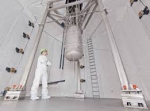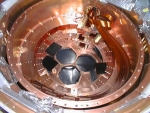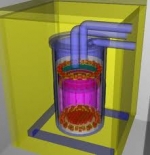Displaying items by tag: WIMP
LUX dark matter detector
The Large Underground Xenon Detector (LUX) is a 370 kg liquid xenon physics experiment that aims to directly detect interactions between Weakly Interacting Massive Particle (WIMP) dark matter and ordinary matter on Earth.
Despite the wealth of evidence supporting the existence of non-baryonic dark matter in the Universe, dark matter in our galaxy has never been directly detected on Earth. The LUX experiment utilizes a large detector mass in a time-projection chamber (TPC) configuration to identify individual particle interactions in the liquid xenon volume, which will allow it to look for faint dark matter interactions with unprecedented sensitivity.
The LUX experiment is located 4,850 ft (about 1 mile) underground at the Sanford Underground Research Facility (formerly the Deep Underground Science and Engineering Laboratory) in Lead, South Dakota. Underground, the detector is located in the Davis campus, the former site of the Nobel-prize winning Homestake neutrino experiment led by Raymond Davis. The LUX experiment needs to be operated underground in order to reduce signal background caused by high-energy cosmic rays at the Earth's surface.
The LUX experimental collaboration is composed of more than 100 scientists and engineers across 18 institutions in the US and Europe.
The detector assembly began in late 2009. The fully assembled detector was transported from the surface laboratory to the underground space in a two-day operation in the summer of 2012.
Cryogenic Dark Matter Search (CDMS)
The Cryogenic Dark Matter Search (CDMS) is a series of experiments designed directly to detect particle dark matter in the form of WIMPs.
Using an array of semiconductor detectors at millikelvin temperatures, CDMS has set the most sensitive limits to date on the interactions of WIMP dark matter with terrestrial materials. The first experiment, CDMSI, was run in a tunnel under the Stanford University campus. The current experiment, CDMSII, is located deep underground in the Soudan Mine in northern Minnesota.
SuperCDMS is the successor to CDMS II. The "super" refers to the larger, improved detectors. There are actually three generations of Super CDMS planned:
- SuperCDMS Soudan, with 9.3 kg of active detector mass made of 15×620 g germanium discs (76.2 mm/3″ diameter × 25.4 mm/1″ thick). This has been operating since March 2012.
- SuperCDMS SNOLAB, with 100–200 kg of active detector mass, made of 1380 g germanium discs (100 mm/3.9″ diameter × 33.3 mm/1.3″ thick). Development is underway, and it is hoped construction will begin in 2014. The deeper SNOLAB site will reduce cosmic ray backgrounds compared to Soudan.
- GEODM (Germanium Observatory for Dark Matter), with more than 1000 kg of detector mass. Preliminary planning hopes to install this in the DUSEL laboratory.
XENON Dark Matter Search Experiment
The XENON Dark Matter Search Experiment aims to construct a next-generation dark matter detector, which will use liquid xenon as the target material for finding Weakly interacting massive particles (WIMPs). The collaboration is led by the Columbia University.
A 15 kg liquid xenon detector was installed at Gran Sasso underground laboratory in Italy during March 2006, and searchedfor WIMP interactions until October 2007. No WIMP signatures were found, the limits on WIMP-nucleon cross sections extend down to below 10−43cm2 for a 30 GeV/c2 WIMP mass.
The current phase, XENON100, for a total of 150 kg of liquid Xenon, is running at the Gran Sasso Laboratory. XENON100 is expected to achieve a factor of 50 better sensitivity, compared to XENON10. The next generation XENON detector will reach another order of magnitude sensitivity to cover SUSY parameter space down to 10−46cm2 by 2012.
The collaboration is currently designing Xenon1t whose fiducial volume will contain 1 ton of ultra radio-pure liquid Xenon.
Participating universities in XENON100 include: Columbia University (USA), Johannes Gutenberg Universitat, Mainz (Germany), Gran Sasso National Laboratory (Italy), Max-Planck-Institut fur Kernphysik (Germany), Rice University (USA), Shanghai Jiao Tong University (China), SUBATECH, Universite de Nantes (France), University of Bologna andINFN-Bologna (Italy), University of California - Los Angeles (USA), University of Coimbra (Portugal), University of Munster (Germany), University of Zurich (Switzerland),Weizmann Institute of Science (Israel)
Participating laboratories in XENON10 include: Brown (USA), Case Western Reserve (USA), Columbia (USA), Gran Sasso National Laboratory (Italy), Lawrence Livermore National Laboratory (USA), Rice (USA), Coimbra (Portugal), University of Zurich (Switzerland), and Yale (USA).
High Energy Stereoscopic System (HESS)
The High Energy Stereoscopic System (H.E.S.S.) is a next-generation system of Imaging Atmospheric Cherenkov Telescopes (IACT) for the investigation of cosmic gamma rays in the 100 GeV and TeV energy range. The acronym was chosen in honour of Victor Hess, who was the first to observe cosmic rays.
The name also emphasizes two main features of the currently-operating installation, namely the simultaneous observation of air showers with several telescopes, under different viewing angles, and the combination of telescopes to a large system to increase the effective detection area for gamma rays.
H.E.S.S. permits the exploration of gamma-ray sources with intensities at a level of a few thousandth parts of the flux of the Crab Nebula. H.E.S.S. has four telescopes, each with a mirror just under 12m in diameter, arranged 120m apart from each other in a square. A larger telescope with a 30m mirror called H.E.S.S. Phase 2, constructed in the centre of the array, saw its first light at 0:43 a.m. on 26 July 2012.
As with other gamma-ray telescopes, H.E.S.S. observes high energy processes in the universe. Gamma-ray producing sources include supernova remnants, active galactic nucleii and pulsar wind nebulae. It also actively tests unproven theories in physics such as looking for the predicted gamma-ray annihilation signal from WIMP dark matter particles and testing lorentz invariance predictions of loop quantum gravity.
The H.E.S.S. observatory is operated by the collaboration of more than 170 scientists, from 32 scientific institutions and 12 different countries: Namibia and South Africa, Germany, France, the UK, Ireland, Austria, Poland, the Czech Republic, Sweden, Armenia, and Australia. To date (Aug. 2012), the H.E.S.S. Collaboration has published over 100 articles in high-impact scientific journals, including the top-ranked ‘Nature’ and ‘Science’ journals.





































